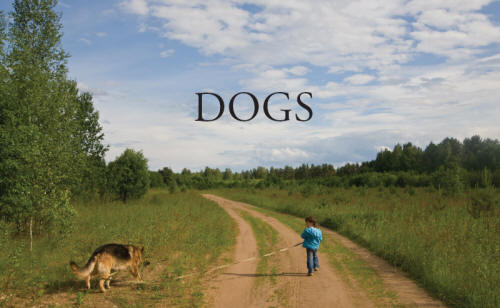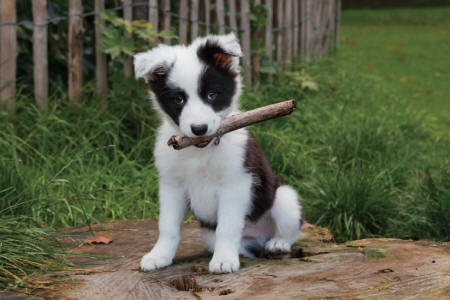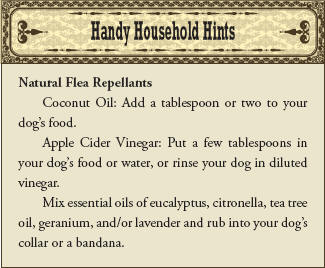
Loveable, loyal, and eager to please, dogs are a welcome addition to any family. The first few months with your new dog, regardless of its age—an adopted middle-aged dog may be as poorly housebroken as a puppy—can be a trying time for your patience and your carpet. Housetraining an animal is difficult, whether you’re a recent college graduate looking to share an apartment with a furry friend or whether your history with animals is long and varied.
Start a relationship with your vet within the first 48 hours of bringing your dog home. Doing this can ensure that your dog doesn’t have any physical conditions that may prevent it from being trained properly. You should also have the dog food ready; a high quality brand of dry (kibble) food is recommended. Keep your dog on a consistent diet by refraining from offering table scraps or changing the food brand. Not only do available table scraps encourage later bad habits, but scraps, wavering food brands, and wet food itself can give your dog diarrhea or loose stool resulting in accidents that are even more difficult to clean up. If you ever do need to change your dog’s diet for any reason, do so gradually, over a span of 4-7 days.
Housetraining
The three things you need to remember about house-training are:
Constant supervision is absolutely necessary.
Concentrate on prevention rather than punishment.
Be patient!
If you can keep these in mind, housetraining will not only be quicker, but it will be a better experience for both you and your dog.
As soon as you bring your dog home, take it outside. Let it get acquainted with the yard, the exercise area, the route you may walk most often. Wait until the dog “goes” before taking it back inside, and once that happens, make sure you praise your dog. The next few days you may be offering a ridiculous amount of praise, but you should understand that dogs want to please. If you can make them understand what you want from them, what makes you happy, they’ll be more receptive through praise than punishment.
However, be realistic; your dog will most likely have an accident in the house, which will undoubtedly frustrate you. You can’t punish the dog after the damage is done, though. Dogs live moment-to-moment; they assume that whatever they’re doing at the exact second they’re punished is what made you upset. Catching your dog in the act of piddling on the floor and showing your disapproval will make more sense to the dog, but this is dependent on constant supervision. Watch for signs of your dog needing to relieve itself, like turning in circles, sniffing the floor, or abruptly running out of sight. Older dogs may be able to control their bowels and bladder much better, but puppies aren’t able to control the same muscles until they’re about 12 weeks old. Puppies need to pee around six times a day, so by keeping close watch, you can avoid those six accidents.

Once you catch your dog in the act, your tone of voice is plenty to get the point across that you’re not pleased. You can say whatever you want, as long as you keep it consistent every time. Promptly bring your dog outside to the appropriate piddling place and wait for it to “go” again. If and when it does, bestow praise on the dog.
It’s smart to confine your dog to a certain part of the house (perhaps the rooms without carpets) or to a crate until it is housebroken. This is especially good if you work all day. Dogs should not be stuck inside their crates all day, however; that dog is likely to become neurotic, unhappy, destructive, and noisy.
Your dog’s crate should be big enough for the puppy’s bed, but no larger. This is because dogs dislike the idea of soiling their bed, so using a crate that is essentially their bed, teaches them to control the urge to “go.” You should keep the puppy in the crate when you aren’t with him, but do not use it as punishment. It should be a safe space for your dog. Also, remember that if you keep your dog in a crate, that time must be balanced with a sufficient amount of exercise and companionship.
Define a bathroom schedule for your dog: it should be the first thing you do in the morning, the last thing you do every night, and what you do after every meal and play session. When you go for a walk, try not to return home (or inside) with your dog until it has gone to the bathroom. Pay attention to your dog’s behavior and where it goes to the bathroom and share the information with any other person engaging in the housebreaking process. Using a word, like “outside,” and visiting the same spot helps cement the idea that there is a certain place and time to “go.”
These frequent trips outside will continue until you reach the five month mark. Once there, you can start to trust that your dog understands where to go and is able to “hold it” until you are there to make it possible.
If you’ve brought home a small, toy breed that will be inside most of the time, you can opt to paper train it. Start with some sort of dog pen or confined space and place your dog’s food and water at one end with layered newspaper at the opposite. Not only do dogs dislike soiling their bed, but they feel similarly about relieving themselves near their sustenance. Once your dog has eaten, lead it towards the newspaper, wait until it “goes,” and make sure to praise him. Afterwards, replace the newspaper with new sheets, but leave the bottom layer. This leaves their smell behind and reminds them of where to “go” next time. Make sure to remain consistent with the placement of the newspaper so as to not confuse your dog.
Because there will undoubtedly be accidents, neutralize the odor—dogs like to return to places they have “gone” before—with a pet odor neutralizer.
With patience, a keen eye, and praise and prevention in favor of punishment, housetraining your dog will become a simpler, shorter process.
Grooming
Make sure that you keep your dog’s fur clean by brushing the coat a few times a week (more frequently for long-haired dogs), or whenever it looks dirty. Every time you brush your dog check it for any injury or illness; notice the eyes, ears, teeth, and nose. How frequently you should bathe your dog depends on what type of hair it has, but generally a good bath every few weeks will keep your pup clean and healthy. Keeping nails trimmed is essential—a dog’s nails are constantly growing and usually do not wear away on their own. Untrimmed nails can lead to infection or injury. You can purchase dog nail clippers at any pet supply store. Be careful when clipping your dog’s nails—they still have living tissue in the upper part of the nails, and clipping them too short can hurt your dog. If you feel unable to trim your dog’s nails yourself, a vet or groomer can do it for you.
Dogs love to play outdoors, which means they’ll be regularly exposure to bugs and parasites. Be sure to keep your dog protected from fleas, ticks, and other parasites. Unwanted pests can bite and spread disease to your dog, and be carried into your house. There are many different flea/pest control medications available; just ask your vet which one is best for your dog.
Socializing
Dogs are social creatures and need continual stimulation and interaction to be happy. You can “socialize” your dog by taking it on walks, having it encounter other dogs and people, and playing with your dog. Encourage your dog to explore its environment. Socialization is especially important for puppies, as they are still learning about their environment, and socialization will lead to a better behaved and well-adjusted dog. A bored or unhappy dog can be a destructive dog.
